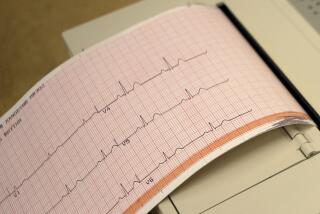Fear created by the unknown
- Share via
My waiting room was filled with patients, but one in particular was telling the nurse that he couldn’t bear to wait another moment. He was an international businessman, and I could hear his nervous speech through the waiting room window glass.
I had ordered a CT scan on “Mr. Azziz” during a routine physical because he was a smoker. I had always reassured smokers that the test was routine, that a CT scan was more sophisticated than an X-ray in analyzing a smoker’s lungs. But knowing that a CT scan or other state-of-the-art test could tell the future made many patients anxious, worrying about the results.
He had gone for the scan a few weeks after seeing me. The report had arrived several days later, indicating a 3-centimeter nodule at the top of the lung, consistent with cancer.
I had told the office nurse that I needed to see “Mr. Azziz” right away. By the time of his appointment, he was as nervous as any patient I could remember.
The report says there’s a nodule, I said. But it’s small -- and there are no swollen lymph nodes. It may well not be cancer; if it is, we should be able to operate on it and cure you.
This helped to calm him only slightly.
There’s another scan we can do first, I said -- a PET scan, which senses heat or metabolic activity. It will give me a better indication if this is an active lesion or just an old scar. Either way, I told him, I think we’re going to need to do a needle biopsy to be sure. I want to know as soon as possible, he said, squeezing his ears and scratching the sides of his face in his extreme nervousness. I invited him into my corner consultation room, a sanctum with white brick walls and many windows.
“Mr. Azziz” seemed to relax somewhat at being out of the stark exam room. He sank into the soft blue leather of my couch, as if the news couldn’t get any worse in here.
I decided to show the CT scan to my office mate, a prominent pulmonologist. He crisply snapped the scan up onto his view box. This type of precision and ease at looking at potential cancers could frighten a patient if he saw it. The report already had the words “suspicious for a bronchogenic neoplasm” written on it. Like the lung doctor, the radiologist who had interpreted the X-ray was pronouncing sentence on a man he’d never met. The technology told your future and could take away your hopes and plans with a single verdict.
A great diagnostician and a feeling physician, my office partner always looked for nuances. He analyzed all the different possibilities. It could be cancer, he said, but it might just be a scar; it needs a biopsy, but it could well be negative.
I brought this news back to “Mr. Azziz,” who visibly relaxed. There was a tangible hope between us. We could envision a scenario that didn’t involve cancer or lead to surgery.
Cancer would give mortality a name and a timetable; a negative result would return mortality to the abstract.
He wanted the biopsy as soon as possible, and as he rose to go, I could almost feel the fear welling up again. .
We both pushed to know the answer as soon as we could. Despite impassive clerks, loaded appointment schedules and the automatic alienation of managed care medicine, I gave this man all the VIP status I could muster, internally with my staff and externally with other staffs. I could sense his helplessness, his guilt over his years of smoking -- risking his children to a fatherless future.
The biopsy revealed squamous cell cancer that had not spread.
Although an operation cured “Mr. Azziz,” I know his fear is tied to imagining the worst. In his case, that recurring fear will be much more difficult to control than the cancer.
Still, there is a positive aspect to being afraid: He is certain, that no matter what happens, he will be too frightened to ever smoke again.
*
Marc Siegel is an associate professor of medicine at New York University School of Medicine. He can be reached at marc@doctorsiegel.com.






